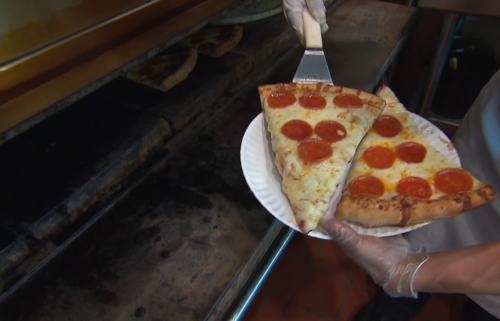Hal Marcus painting being moved from Chamizal National Memorial after more than 30 years

 by Robert Moore
by Robert Moore
May 20, 2025
Sign up for essential news about El Paso. Delivered to your inbox — completely free.
A large painting by El Paso artist Hal Marcus that has greeted visitors to the Chamizal National Memorial for decades is looking for a new home.
“El Paso Gracias a Dios,” a 9-by-11-foot painting, has been on display at the Chamizal in South Central El Paso since shortly after Marcus created the work. But Chamizal officials notified Marcus a year ago that the painting needed to be moved to help the memorial comply with federal policies, said Gerardo Gonzalez, the Chamizal’s superintendent.
“Chamizal National Memorial and Mr. Marcus do not have any formal agreement that authorizes the long-term housing of the mural within the visitor center, which would be needed for continued display of the mural,” Gonzalez said in a statement to El Paso Matters.
Marcus initially expressed concerns to El Paso Matters that the artwork was being removed for political reasons, but later said he was satisfied with Gonzalez’s explanation.
“I want it to be seen,” Marcus said.
He said he’s had conversations with the city and county governments about potentially housing the painting. He said he’s open to selling the artwork, which he said is valued at $200,000, or loaning it for display.
The artwork features the diverse peoples that have made their home in the El Paso region coming together for a Thanksgiving celebration.
“I just think it’s a beautiful piece that represents the beauty of our culture,” said Leilainia Marcus, the artist’s daughter. “We have El Paso, New Mexico and Mexico. We’re all together here in this co-existing planet, and we get along pretty well, actually.”

City Rep. Chris Canales said he reached out to Marcus after learning that the painting might need to be moved from the Chamizal.
“I talk to Hal somewhat frequently, and I told him if the painting needs a landing place, I’d love to give him one at City Hall where people can still enjoy it,” he said.
Canales said city officials still need to negotiate with Marcus over a loan of the painting. He said he didn’t think the city would be interested in buying the artwork.
Gonzalez said the decision to ask Marcus to move “El Paso Gracias a Dios” began with an audit several years ago that found that the Chamizal was not complying with federal rules for special use permits for use of the facilities.
The memorial – which celebrates the 1963 treaty that ended the last boundary dispute between the United States and Mexico – adopted new special use permit standards in 2021, which said that indoor spaces like the visitor center housing Marcus’ artwork were no longer eligible for special use permits.
The Chamizal continues to contract with artists for short-term displays. The Memorial Gallery currently has a display of artwork by University of Texas at El Paso students that focuses on iconic moments in national park history.
Gonzalez said the only contract between the Chamizal and Marcus was one from November 1993 that allowed his painting to be displayed for a year.
“So, there was something in writing that said they were going to display for one year, and somehow it just grew into this permanent loan, which, going into archives, we still can’t find how that ever happened,” Gonzalez said in an interview with El Paso Matters.
The Chamizal informed Hal and Leilainia Marcus in May 2024, shortly after Gonzalez arrived as superintendent, that the painting would need to be removed.
“I didn’t give them a timeline back in May of 2024, and I’m not giving them a timeline now,” he said.
During the conversations, the Marcuses and Gonzalez said the First Amendment was raised, which created some misunderstandings.
“They said, ‘We’re going to have to find a new home for it because we no longer have free speech in government buildings,” Leilainia Marcus told El Paso Matters.
Gonzalez said that came from an effort to explain why policies required the removal of the painting. Because Marcus didn’t have a special use permit or a contract to display the painting, the artwork was a form of free expression by the artist.
Most national parks and memorials, including the Chamizal, have established designated First Amendment areas, which allow for individuals and small groups to gather for the purposes of expression without need for a permit. The Chamizal’s designated area is outside and south of the visitor center.
“Chamizal remains committed to fulfilling its mission — celebrating the diverse cultures of the borderlands and promoting mutual respect — while also adhering to agency regulations and policy regarding use of park spaces,” Gonzalez said.

He said the decision to remove “El Paso Gracias a Dios” is not connected to President Trump’s executive order on art displays at Smithsonian museums and national historic sites.
“This process actually started in May of 2024 under the Biden administration,” Gonzalez said. “I just wanted to clarify that the Trump administration has nothing to do with the decisions that we’re making here at the Chamizal about this particular art piece.”
Hal Marcus said that his work is driven by “peace and love,” which he said can be viewed as political. But his intent is to celebrate a region he loves.
“As far as radical art, pfft, this is nothing. In my opinion, it’s the artist’s dream that’s quite unique because I was able to put it on canvas – all the elements that you would dream about to make our culture,” he said.



